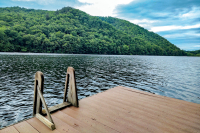Girls on the Run: Training girls for a 5K, preparing them for life
Much can be learned through the process of training for a 5K race — physical strength, mental health, focus, determination, self-confidence and perseverance.
Resolve to be active in 2017: WNC runs and rides offer ample options for fitness goals
January is universally recognized as the time to make a fresh start, throw away last year’s used-up calendar and dream up a new set of aspirations for the 12 months ahead. And when it comes to New Year’s resolutions aimed at becoming more active in 2017, Western North Carolina offers a dazzling array of options.
Completing Waynesville half marathon was a real thrill
 There was a time when running was my saving grace. If I didn’t run at least four times a week, I could feel it in my body and in my mood. It was a must for me. I wrote about running all of the time on my blog. I participated in races all throughout the year.
There was a time when running was my saving grace. If I didn’t run at least four times a week, I could feel it in my body and in my mood. It was a must for me. I wrote about running all of the time on my blog. I participated in races all throughout the year.
This must be the place
 It is the single most essential thing in my life.
It is the single most essential thing in my life.
Running. The action of putting on jogging shorts, a comfortable t-shirt, lacing up your shoes and heading out the front door for the open road. It is oxygen for my soul, lighting in a bottle for my heart, and sanity for my brain.
One foot in front of the other: Haywood runner seeks to push her limits, share the joy of running
 Pushing through 2.4 miles of swimming, 112 of biking and 26.2 of running, it was all Jennifer Jacobson could do to keep moving toward the finish line of Ironman Louisville in Kentucky last summer. But she did make it, earning an achievement to boost her mood for years to come.
Pushing through 2.4 miles of swimming, 112 of biking and 26.2 of running, it was all Jennifer Jacobson could do to keep moving toward the finish line of Ironman Louisville in Kentucky last summer. But she did make it, earning an achievement to boost her mood for years to come.
“That was basically an ultimate bucket list goal for me, and if I don’t ever do another one again, I’m OK with that,” said Jacobson, 33. “But just having that experience was something I’ll never forget for sure.”
This must be the place
 All I wanted to do was play soccer.
All I wanted to do was play soccer.
In the summer of 1997, I was 12 years old and ready to enter seventh grade in upstate New York. Until that point, I had attended a small Catholic elementary school. Now, I was finally entering public school, middle school no less, where a whole new world awaited me.
‘We’ll go back’: Sylva doctor who helped at Boston bombing vows not to let terrorists win
As the manhunt ends, the nation begins to cope and the primary suspects in the Boston Marathon bombing either lay dead or in custody, Dr. Allan Panter, a Sylva emergency room doctor who visited Boston for the race, is still reliving — in vivid detail — the brutal events of that day.
Sometimes a walk is better than a run
 For many years I was a dedicated runner. These days I’m much more likely to choose to walk, both for exercise and pleasure.
For many years I was a dedicated runner. These days I’m much more likely to choose to walk, both for exercise and pleasure.
I enjoyed running, particularly trail running. There was a sense of freedom and power about running through the woods that I sometimes remember with longing. But you miss a lot when you run. There are all these goals involved: Improve your time, or run a certain distance, or something along those lines. By comparison walking seems pressure free. There are no particular goals, or at least I don’t set goals for walking. I tend to amble along enjoying what there is to see. Henry David Thoreau put it best when he noted “it is a great art to saunter.” It is indeed.
By foot or by bike: New running and cycling clubs hit their stride in Cherokee
Anyone can run or bike. And if any two people could testify to that, it’s Gerri Grady and Hugh Lambert.
Both Grady and Lambert have used exercise to overcome health problems. Now, both are leaders in two separate exercise- and social-centric clubs in Cherokee, aimed at promoting healthy lifestyles among members of the Eastern Band of Cherokee Indians.
Back in the 1990s, Grady, a founding member of the Cherokee Runners, could hardly walk, let alone run.
“I started walking because I was a heavy smoker,” said Grady, secretary of the running club. “God. I could barely walk.”
Following the death of her mother from asthma-related complications in the mid-1990s, Grady was determined to get fit and began strolling a 3-mile circuit a couple of times a week with her sister.
“I got scared because of that,” she said of her mother’s death.
Walking eventually gave way to running, and in 2001, Grady ran her first 5K and quit smoking. Now, she is a dedicated runner.
Like Grady, Lambert battled his own health problems — including sleep apnea and diabetes — before he took up cycling and started Cherokee Riders Cycling Club. Formerly 300 pounds, a now 205-pound Lambert has made strides to improve his overall health.
“There is no magic pill,” he said. “Take responsibility for your own health and actions.”
Lambert tried road cycling in college but did not keep it up. In the mid-90s, he tried again with mountain biking, but his carpel tunnel caused his hands to numb.
However, last year when Lambert heard about a Trail of Tears bike ride, things changed.
“I just had to do it,” he said.
Remember the Removal is an annual three-week bicycle ride commemorating the forced removal of the Cherokee Nation from its homelands during the 1830s - a brutal march where thousands of Cherokee perished from starvation and exposure. Riders retrace the route of the Trail of Tears through Georgia, Tennessee, Kentucky, Illinois, Missouri, Arkansas and finally to Oklahoma. The ride is exclusive, only seven or eight ECBI members can participate each year. The Cherokee Nation in Oklahoma also sends 10 cyclists to complete the ride.
Desiring to be one of those, Lambert bought a bike and began self-training last spring. He figured that if he could ride 6.5 miles from Cherokee to Waterrock Knob on the Blue Ridge Parkway, which climbs more than 3,000 feet in elevation, then he would be able to make the 950-mile trek to Oklahoma.
“It took me 3.5 hours to not make it half way,” said Lambert, who was impeded by some late winter snow.
But, two weeks later, he completed a similar length ride in Sylva and improved from there.
Club genesis
For years, Grady ran only with fellow enthusiasts from her family, but she continued to see other familiar faces along her running routes.
“I always saw the same people out on the trail,” Grady said.
When winter came, Grady moved inside to a local fitness center, and those familiar faces followed.
“And again, we are seeing all these people who have the same enjoyment,” she said.
However, it was not until spring 2009 when Grady and some of her family members went on vacation to Myrtle Beach that the idea of a running club initially arose. To gauge people’s interest, Grady sent out a Facebook message to her friends, many of whom also ran, advertising a meet-up and the possible formation of a running club.
“Oddly enough, here they came,” Grady said. “It’s just awesome.”
Cherokee Runners has grown from 15 to 40 members since its first meeting. And, as an official club, members have crossed the finish line in three marathons and countless half-marathons, 5Ks and 10Ks.
Members of the club meet regularly throughout the week with a longer run scheduled for Sundays. After a jaunt, the runners eat oranges and socialize while cooling down, Grady said.
“It’s not about competition so much as it is about health and fitness, and social (experiences),” she said, adding that anyone can join.
Taking a cue from the Cherokee Runners, Lambert decided to gather other cycling lovers and form the mountain and road biking club — Cherokee Riders.
“Mostly, we liked to ride, and we wanted to get other people involved,” he said.
Although it is not yet an official club, Cherokee Riders already has 10 members. It hopes to gain official club status, which includes crafting bylaws and membership applications, by the end of the month.
A main focus of the club is to raise money for Remember the Removal participants and help train them. The ride costs about $5,000 per person, as each is custom fitted with a bike.
This year, 22 people applied to be one of the seven who gets to represent the Eastern Band on the three-week ride.
During the ride, members of the national nonprofit Trail of Tears Association meet with the riders to give talks and programs during their overnight stops. Participants are “exposed to culturally significant places” along the way, he said. “Everybody who’s gone on the ride said it changed their life.”
Civically minded
As part of its mission statement, the Cherokee Runners participate in health fairs, training programs and hosts lectures. Speakers give a rundown of what to wear when exercising during the bone-chilling winter months and the sizzling summer months, how to deal with injuries, and training techniques. All of these outside activities are aimed at promoting exercise and fitness to residents of Cherokee.
“We try to be in the community, visible,” Grady said.
The club also sponsors runs and plans to hold a summer running camp for community members.
In the future, Grady and Lambert said they hope both clubs can work together toward their common goal — to get people to maintain a healthy lifestyle.
“They (the running club) are kind of a role model for community involvement,” Lambert said.
Once it’s more established, Cherokee Riders plans to offer bike safety courses, kids camps, training and, if the funds become available, a bike rental program.
Kick up your heels
The Cherokee Runners meets at 7 p.m. the first and 15th of every month in the Age Link building, behind the Yellowhill Community Club. However, if the meeting date falls on a church day, it is pushed back to the following day. Members also gather for runs throughout the week and go for a longer run every Sunday. To join in the weekly runs or for more information about the club, contact Gerri Grady at 828.497.7083 or This email address is being protected from spambots. You need JavaScript enabled to view it..
Get peddling
A new cycling club is forming in Cherokee. The Cherokee Riders will hold an organizational and interest meeting at 2 p.m. on Sunday, Feb. 12, at the Emergency Operations Center in Cherokee, followed by a group ride. The club will hold weekly group rides. For more information about the club or their rides, contact Hugh Lambert at 828.554.6810 or This email address is being protected from spambots. You need JavaScript enabled to view it..
A great race makes a comeback
There aren’t too many road races in Western North Carolina with the storied history of the Maggie Valley Moonlight Race, sponsored this year by Mission Health System. Nor will you find many, like this one, that take place at night.
Which is exactly why Sean Grady of Cherokee is so inclined to run the upcoming 8K on Aug. 27. He wants to run this race even though he’s preparing for the Marine Corps Marathon on Oct. 30 in Arlington, Va., and despite his careful efforts otherwise to adhere to a peak-at-the-perfect-moment training regimen.
And Grady’s marathon training plan certainly does not call for a 4.8-mile road race this coming weekend.
But that’s the allure of the Maggie Valley Moonlight Race, which in its heyday attracted more than 2,300 people to this Haywood County community. The race has been subject to fits and starts over the last decade — this is the first time in a couple of years it’s been held — but the reputation of the nighttime run is legendary.
“We want to bring back some of the traditions of the race,” said Greg Duff of Glory Hound Events in Asheville, who is organizing this 30th version of the Moonlight Race.
That includes inviting regional running clubs to the run, one of the great traditions Duff wants back. Clubs would have “tailgate” parties, swap meets and meetings for members, and generally good times were had by all.
Grady and wife, Gerri, both belong to Cherokee Runners, a club on the Cherokee Indian Reservation. While Sean Grady is still vacillating a bit about whether to run the race as a tempo run (an outing done at a steady effort level, these runs are generally just a little slower than a runner’s average 10K race pace, helping to develop anaerobic or lactate thresholds), his wife is definitely participating, as are others with the Cherokee running club.
They’ll find an excellent course with plenty of running support, said Duff. The rectangular course takes runners 1.2 miles up the valley to Ghost Town, then 2.4 miles in the opposite direction, before returning them 1.2 miles to the finish line back at the fairgrounds.
The race gets under way at 8:30 p.m.
Want to run the Maggie Valley Moonlight Race?
Cost: $30, with registration/packet pickup on Friday, Aug. 26 from 3-6 p.m. at the Maggie Valley Fairgrounds and from 4-8 p.m. Saturday, Aug. 27 at the fairgrounds.
Time: Race starts at 8:30 p.m.
Awards: 10 p.m. at the fairgrounds stage.
Post race: Budweiser of Asheville is a race sponsor, and all runners, 21 years and older, will be able to receive one beer after the race. Bottled water will also be available at the finish line and food tent.













